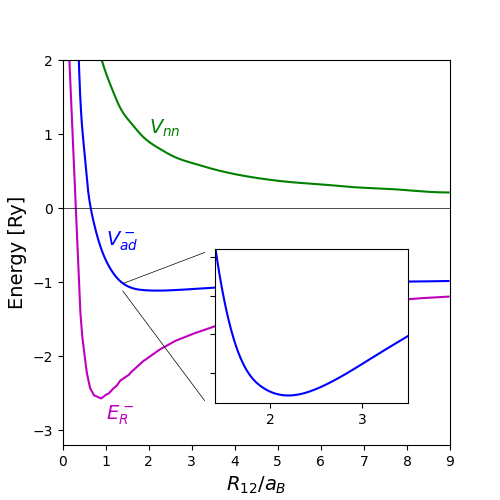
|
Main /
WikiSandbox(redirected from PmWiki.WikiSandbox) Feel free to use this page to experiment with the Text Formatting Rules. Just click the "Edit Page" link at the bottom of the page. {$$E_k\left(\frac {\theta_0} 2\right) + U\left(\frac {\theta_0} 2\right) = U(\theta_0) + \underbrace{E_k\left({\theta_0} \right)}_{0} $$} {$$E_k\left(\frac {\theta_0} 2\right) = mgl\left[\cos(\theta_0/2)-\cos(\theta_0)\right]$$} {$$ \begin{matrix} I_\pm(t) I_\pm(t-\tau) & & e^{i\gamma B(\mp t \mp (t-\tau))} =& e^{i(\mp 2t \pm \tau)}\\ I_\pm(t) I_\mp(t-\tau) & & e^{i\gamma B(\mp t \pm (t-\tau))} =& e^{\mp i \tau}\\ I_\pm(t),I_z(t-\tau) &\mbox{ leading to oscillating terms }& & e^{\mp i\gamma Bt} \\ I_z(t) I_\pm(t-\tau) & & & e^{\mp i\gamma B (t-\tau)}\\ I_z(t)I_z(t-\tau) & & & 1 \\ \end{matrix} $$}  prova m3 {$$ \begin{align*} A_{20} &= \sqrt{\frac 3 2} D_{zz} = \sqrt{\frac 3 2}(3\cos^2\theta-1) \propto Y^0_2(\theta,\phi)\\ A_{2\pm 1} &=\mp (D_{xz}-iD_{yz}) = 3\sin\theta\cos\theta e^{\mp i \phi} \propto Y^{\mp 1}_2(\theta,\phi)\\ A_{2\pm 2} &= \frac 1 2 (D_{xx} - D_{yy} \pm 2i D_{xy}) = \frac 1 2 \sin^2\theta e^{\pm 2i\phi} \propto Y^{\mp 2}_2(\theta,\phi) \end{align*} $$} {$$ \begin{align*} A_{20} &= \sqrt{\frac 3 2} D_{zz} = \sqrt{\frac 3 2}(3\cos^2\theta-1) = Y^0_2(\theta,\phi) \\ A_{2\pm 1} &=\mp (D_{xz}-iD_{yz}) = 3\sin\theta\cos\theta e^{\mp i \phi}= Y^{\mp 1}_2(\theta,\phi) \\ A_{2\pm 2} &= \frac 1 2 (D_{xx} - D_{yy} \pm 2i D_{xy}) = \frac 1 2 \sin^2\theta e^{\pm 2i\phi} = Y^{\mp 2}_2(\theta,\phi) \end{align*} $$} We first divide by a to get {$ %num=1% x^2+b/ax+c/a=0 $} Then we complete the square and obtain {$ %num% x^2+b/ax+(b/(2a))^2-(b/(2a))^2+c/a=0 $} The first three terms factor to give {$ %num% (x+b/(2a))^2=(b^2)/(4a^2)-c/a $} Now we take square roots on both sides and get {$ %num% x+b/(2a)=+-sqrt((b^2)/(4a^2)-c/a) $} Finally we move {$ b/(2a) $} to the right and simplify to get the two solutions: {$ %num=5% x_(1,2)=(-b+-sqrt(b^2-4ac))/(2a) $} Adding a silly note to get a quote as a superscript r' vs. r' {$$ x^2+y^2 $$} {$$ \begin{align} \hbar^2 \overline{\omega_{e+}(t)\omega_{e+}(t-\tau)} e^{-i\gamma B (2t-\tau)} [I_+,[I_+,I_z]] & = -\hbar^2 \overline{\omega_{e+}(0)\omega_{e+}(\tau)} e^{-i\gamma B (2t-\tau)} I_+ & \\ {\color{red} {\hbar^2 \overline{\omega_{e+}(t)\omega_{e-}(t-\tau)} e^{-i\gamma B \tau} [I_+,[I_-,I_z]] } } & = {\color{red}{\hbar^2 \overline{\omega_{e+}(0)\omega_{e-}(\tau)} e^{-i\gamma B \tau} I_+ } } & {\color{red}\longleftarrow} \\ & = {\color{red}{\hbar^2 \overline{\omega_{e-}(0)\omega_{e+}(\tau)} e^{i\gamma B \tau} I_-} } & {\color{red}\longleftarrow} \\ \hbar^2 \overline{\omega_{e-}(t)\omega_{e-}(t-\tau)} e^{i\gamma B (2t-\tau)} [I_-,[I_-,I_z]] & = - \hbar^2 \overline{\omega_{e-}(0)\omega_{e-}(\tau)} e^{i\gamma B (2t-\tau)} I_+ \\ \hbar^2 \overline{\omega_{e+}(t)\omega_{ez}(t-\tau)} e^{-i\gamma B t} [I_+,[I_z,I_z]] & = 0 \\ \hbar^2 \overline{\omega_{e-}(t)\omega_{ez}(t-\tau)} e^{i\gamma B t} [I_-,[I_z,I_z]] & = 0 \\ \hbar^2 \overline{\omega_{ez}(t)\omega_{e+}(t-\tau)} e^{-i\gamma B (t-\tau)} [I_z,[I_+,I_z]] & = \cdots\\ \hbar^2 \overline{\omega_{ez}(t)\omega_{e-}(t-\tau)} e^{i\gamma B (t-\tau)} [I_z,[I_-,I_z]] & = \cdots \\ \hbar^2 \overline{\omega_{ez}(t)\omega_{ez}(t-\tau)} [I_z,[I_z,I_z]] & = 0 \\ \end{align}$$} |